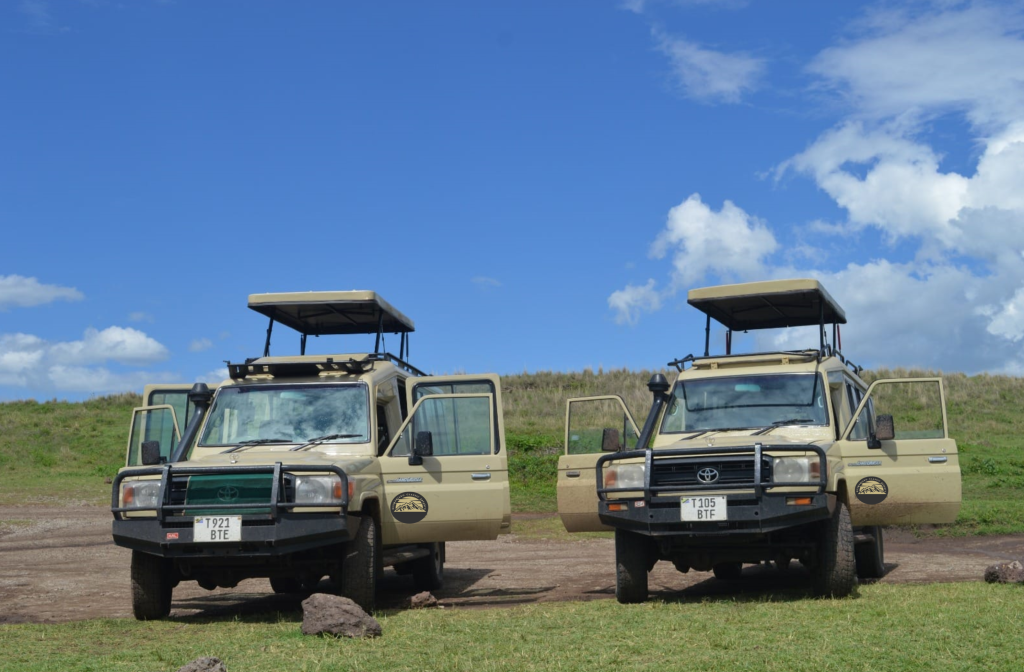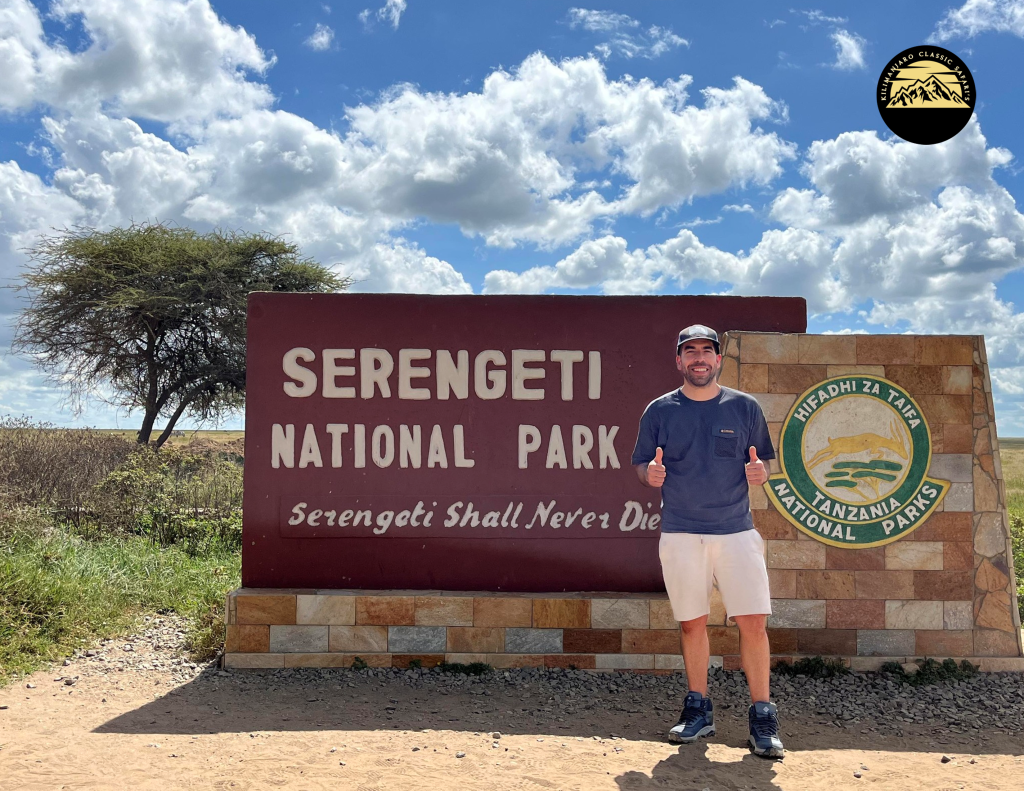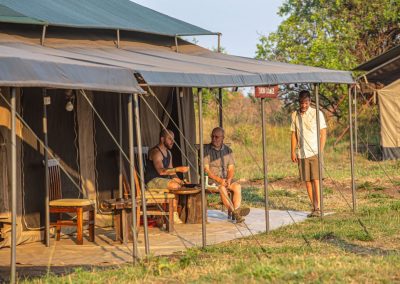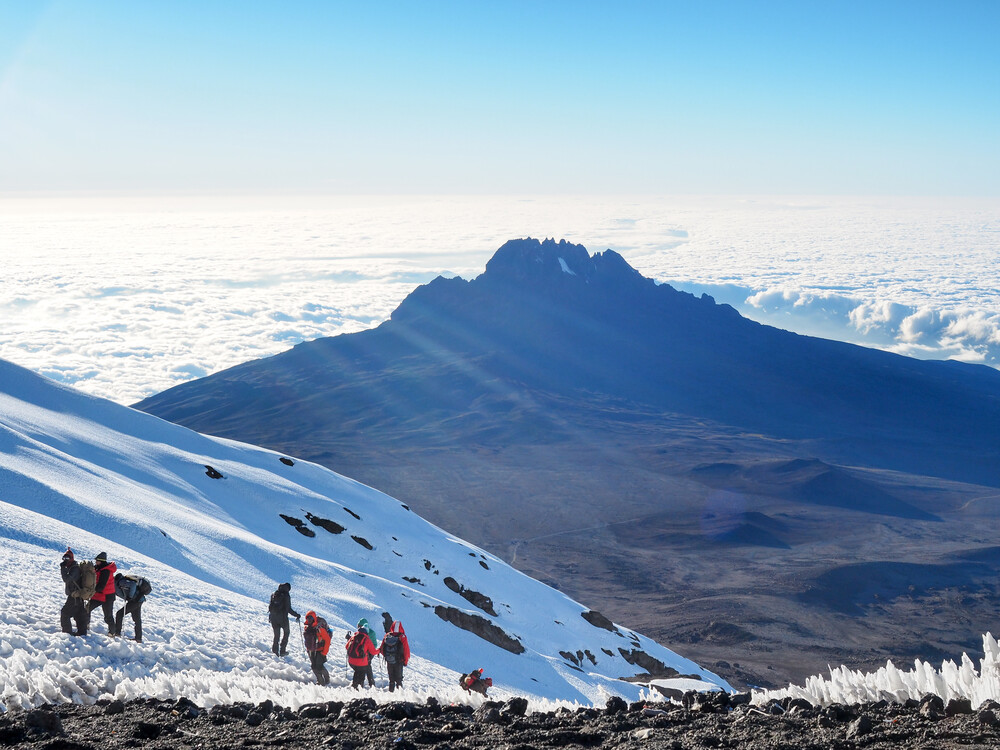THE GREAT ANIMAL MIGRATION
Good news! You can enjoy “the Great Migration any time of year, from December, January, February and March is “CALVING SEASON”. April, May and Early June is “THE TREK NORTH AND THE RUT.” In Late June and July its “THE GREAT MIGRATION” and it continues through to August, September and October.
WHY GO ON
A GREAT MIGRATION SAFARI OVER
OTHER TYPES OF SAFARIS.?
Often referred to as ‘The Greatest Show on Earth,’ it is no wonder that the thousands of guests who flock to Kenya and Tanzania each year in the hopes of seeing this natural event arrive with big expectations! With up to 1,000 animals per kilometers squared, the great columns of wildebeest can even be seen from space. Because the Great Migration can only be experienced in Kenya and Tanzania, these serve as more unique safari destinations than the more standard safaris in southern African destinations. The sought-after safari travel experience gets visitors up close to view animals in an age-old migratory pattern. Since it happens year-round, there’s never a dull moment and visitors receive an up-close experience at any time of year.
THE WILDLIFE YOU WILL ENCOUNTER
ON A GREAT MIGRATION SAFARI
The Great Migration takes place in some of the most wildlife-dense regions on the planet: the Serengeti and Masai Mara. It provides opportunities to see wildebeest, zebra, topi, Grant’s gazelle, Thomson’s gazelle, eland and impala. You can think of the animals as two groups: the travelers and the locals. Wildebeest and zebra are the migratory, and the other animals live in the territory that the migration passes through. Beyond the unique dramatic
spectacle of the huge herd of animals moving across the continent, you also see an immense variety of plains game, predators, river-based animals and birds.
The predator-prey relationship is on active display. The migration passes through lion, leopard and cheetah territories, providing Hunting scenes. When crossing the river, wildebeest fight with crocodile in the water, while other predators wait on the plains attempting to ambush the game. During calving season, predators are attracted from far and wide as they seek the chance of easy pickings. The miracle of birth is also observable, as you can witness calves being dropped and learning to walk and run within minutes.
PREDATORS ARE ATTRACTED FROM FAR AND WIDE
AS THEY SEEK THE CHANCE OF
EASY PICKINGS..
WHERE & WHEN CAN YOU GO
TO SEE THE GREAT MIGRATION?
DECEMBER – MARCH
The calving: An estimated 400,000 calves are born which can draw a staggering number of predators eager to pray on the vulnerable young.
APRIL
The trek north: Herds move slowly northwards to fresh
grazing.
MAY – JUNE
The rut: May is the mating season but still the journey continues, some herds move west towards the Grumeti River, and this is the first point on the route
where river crossings can be seen.
JULY – OCTOBER
River crossings: The river crossings usually start in July, but the timing all depends on the rains. Although never guaranteed, crossings can regularly be seen at the Mara and Talek rivers.
THE BEST TIME TO SEE THE GREAT MIGRATION EACH MONTH
Since the Great Migration is an eternal annual cycle from place to place, year in and year out, there is no single time of year to experience it. However, depending on either the aspect of the Great Migration you want to witness
(such as river crossings), or the time of year that you prefer to travel, your
safari can be tailored to give you the best chance of seeing what you desire.
The great migration in December, January, February and March
Calving Season
Around December or January each year, the migration finishes a southward trek, moving along the eastern edge of the Serengeti and into the Ngorongoro
Conservation Area. Here the plains are rich in nutritious grass, providing the herds with the best conditions for raising their newborn calves. Although there is no real beginning or end to this migratory circuit — other than birth and death — it seems reasonable to call the wildebeests’ birthing season the start of the migration. Around late January or February, the herds occupy the short-grass plains that spread over the lower northern slopes of the Ngorongoro Crater highlands and around Olduvai Gorge. Some 400,000 calves are born here within a period of two to three weeks, or nearly 8,000 new calves every day. The abundance of vulnerable young calves means the surrounding predators also spring into action, hunting with ease due to the sheer numbers of wildebeest.
Great migration in April, May and Early June
THE TREK NORTH AND THE RUT
April
As the rains come to an end and the ground dries, the herds start making
their way north into the central Serengeti where the grass is still fresh and they can graze and tend to their young, drawing with them thousands of zebra
and smaller groups of antelope. Moving slowly, they graze as they go, making the most of the fresh grass.
May
By May, impressive columns of wildebeest stretch for several kilometres as the animals start to congregate by the Moru Kopjes, close to Dunia Camp, one of the few camps in the Serengeti that offers migration viewing at this time of year. Mating season begins toward the end of May and male wildebeest battle head-to-head. Throughout ‘the rut,’ the journey continues at leisure with the wildebeest and zebra grazing as they go along.
First half of June
Gradually, the movement gathers momentum and the wildebeest start to mass in the Serengeti’s Western Corridor. At this time of year, the wildebeest face their first challenge of crossing the crocodile-infested Grumeti River. The herds form in huge numbers along the pools and channels of the river, which they have to cross in order to continue on their journey. This may not be as spectacular as the famous Mara crossings, but there are still enough wildebeest to provide The Grumeti crocodiles with a veritable feast. It is worth noting that since May and June are low season at many camps, this time offers lower accommodation rates, since there are relatively low numbers of tourists in the
Serengeti, yet the wildlife viewings remain excellent.
THE RUT
WHERE MALE WILDEBEEST
BATTLE HEAD TO HEAD
The migration in Late June and July
RIVER CROSSING SEASON BEGINS
The herds head toward the north of the Serengeti. The river crossings, considered by some to be the most exciting events of the Great Migration, usually start in July, but timing all depends on the rains.
June
During June, the dry season starts with large concentrations of wildebeest in the western Serengeti and on the southern banks of the Grumeti River. Each migrating animal must face the challenge of crossing the river, filled with
crocodiles — the first of many daunting and tense river encounters.
July
As June moves into July, the migration gathers momentum and huge herds of wildebeest can be seen spread out across the Western Corridor as they continue the journey north. These hundreds of thousands of wildebeest and zebra move along the western edge of the park toward an even riskier barrier: the Mara River in the north of the Serengeti. These river crossings are arguably one of the most exciting wildlife events on Earth. They usually begin at the onset of high season in July, but timing all depends on nature. The herds will typically be found in the northern Serengeti in the month of July, where access s provided by Kilimanjaro classic safari’s two mobile migration camps as well as Sayari Camp (enviably positioned as the closest camp to the Mara River crossing points in the northern Serengeti). Later in July, those animals that have successfully made it across the Mara River will also be found in Kenya’s Masai
Mara, where guests of Rekero Camp can watch river crossings right from the main deck of the camp. At this time, daily river crossings can be seen at the Mara and Talek rivers, both often central to incredible scenes.
The great migration in August, September and October
River crossing continues
August
By August, the herds have faced the challenge of crossing the Mara River and
are spread throughout the Masai Mara’s northern region, with many remaining
in the northern Serengeti. In years when the river is in full flow, the panic and
confusion at the crossings combined with waiting predators and surging
currents — can cause massive loss of life. Many will perish but the thousands of calves that are born more than make up the numbers. Nevertheless, in years of relatively gently flowing water, the crocodile take their toll, not to mention
the lion and other large predators that patrol the banks, ready to ambush any wildebeest that make it to the other side. There is no single crossing: at some spots, there are just a few individuals, while others see a mass of animals
moving without break for hours.
September
By September/October, the main chaos has ended and the migrating columns have gradually moved eastward. The herds are mostly concentrated in the Maasai Mara in Kenya, the northernmost range of the trek, but many still remain in the Serengeti.
October
The wildebeest face the swollen waters of the Mara River once more as they
prepare to cross again on their return journey back south. One of the best
views of the herds migrating out of Kenya across the treacherous Mara River can be found at Baobab luxury tented camp
The great migration in November and December
Calving season begins
November:
After the East African short rains in late October and early
November, the wildebeest move down from Kenya and into
the rejuvenated grasses and eastern limits of the Serengeti
past Namiri Plains, an area known for outstanding cheetah
sightings.
December
By December, the wildebeest are spread throughout the eastern and southern reaches. The Southern Plains are lush with fresh, sweet grasses for the wildebeest to graze on. The areas around Ndutu and the northern Ngorongoro
Conservation Area are where the herds will spend some time enjoying the abundant grazing in preparation for the birth of the new calves in the early months of the new year. The cycle continues as the calving season starts once again
THE SOUTHERN PLAINS
ARE LUSH WITH FRESH
SWEET GRASSES

Top tips while prepare for a great animal migration safari
Plan ahead
Viewing the Great Migration is one of the most popular requests for East African safari itineraries. To secure your first choice of accommodation in your preferred location, you may need to book your trip 12-18 months in advance.
Budget appropriately
River crossings occur during peak season — typically the most expensive months to go on safari. Consider a starting price for a basic safari at US$800 per person, per night (accommodation cost only, excludes park fees). An alternative approach is to travel outside of the high season, which has its own advantages. This time of year will still offer the Great Migration, but costs will lower to around
US$600 per person, per night (accommodation cost only, excludes park fees), and the parks will have fewer tourists and vehicles.
Set aside time
To improve the likelihood of seeing the herds, you will want to spend time in more than one location, so make sure your trip is long enough to do so. We’d recommend staying at two to three camps for a few nights each, and choosing good combinations where the transfers between the camps can be practical and even an enjoyable part of the experience
Consider a private vehicle
Surprisingly, not everyone who is on safari will be interested in seeing the migration. If you share a vehicle with other travelers who have different interests, you might need to compromise with what they’d like to do and see.
With a private vehicle, you’ll have total flexibility. If you want to spend the full day camped out at the river waiting for a crossing, you can do so without having to consider anyone else.
Most importantly, get advice from a safari expert
There are many ways to see the Great Migration, and each traveller will have their own unique requirements around what they would like to see and how they like to travel. An experienced safari expert can save you hours of time sifting through overwhelming amounts of information to help you narrow down your best options. On the ground experts, like the ones at Kilimanjaro classic safari’s, have years of experience coordinating incredible safaris.
Kilimanjaro classic safari’s has a combination of sales and ground operations, so our sales teams are in daily conversation with our expert guides and camp staff who live in the area. Lean on experts to advise you and help you book. Beyond getting the best advice on accommodation and regions to visit, the logistics of a safari, such as park permits and arranging regional flights and transfers, are
also best arranged through local operators.
Our customer expectation to the great animal migration.

Many of our guests will seek us with the aim of documenting the great migration that takes place in the Serengeti and see how our Tanzania is a rich country in East Africa from all the attractions. Sometimes we try to invest a lot of our energy to make sure that all customers are satisfied from our trips to see how animals migrate from Tanzania to Kenya and Ken-ya to Tanzania. Many visitors see this as the main part of their trip because other animals are found in every national park but the migration of animals takes place in the Serengeti and the Masai as soon as there are few places in the Ngorongoro Conservation Area and the animals that migrate are millions of wildebeests, zeb-ras. and a few Impala across the river to the Masai Mara and Serengeti, Kilimanjaro Classic Safari’s take it as part of the fun for customers and education for someone who needs to do research on the cause of the great migration.
If you are ready for this brochure we hope you are part of our family and we believe that the purpose of booking or choosing Kilimanjaro classic safari is to experience something that is different and very spe-cial in your mind after your plan is done. This can teach us to be creative with intel-ligence and service with the aim of making your vision come true, Just to make your dream come true.
Our popular accommodation to the great animal migration.
Kilimanjaro Classic Safari offers different types of Safari to see great mobility and each type of safari has a different price. So the follow-ing is the type of journey that we have to see great mobility;-
Lodges
This according to the accom-modation, we categorize the trip by looking at the type of accommodation that the customer would like to stay after the daily ac-tivities until the tour is over.
Lodges are all hotels that are inside the re-serve and the purpose of this hotel is to en-sure that the guest stays in a place that is very comfortable and these areas are free of human activities.
Therefore Kilimanjaro classic safari’s have com-fortable and luxurious lodges for our customers according to their budget.
This trip takes 2 days and more because to see dif-ferent nature in some parks and other national parks to make customers see different features of the national park that we have not mentioned.
Tented camps

This is a type of trip where accommodation is built like a lodge but in the form of tents. This is a very comfortable accom-modation and it takes a medium budget to afford it. We also have tent camps which are luxury and have different prices than normal tent camps.
Camp
These are small tents that are portable and we are able to move them every-where. Many customers prefer this type of travel because of the low price level to reduce the cost. Always people who think differently about this type of trip or it is not good, The answer is no, because this type of trip brings the real life of the forest, So from this trip you will get many things as a Visitor.
Checklist for choosing your best safari company
Is the specialist an expert on East Africa specifically?
- Do they have their own operations and logistics on the
ground? - Do they offer a range of accommodation, with a high level
of quality throughout? - Do they have a good reputation for safari quality and
reliability, with good safety and COVID-19 hygiene
protocols in place? - Do they support responsible, sustainable tourism?
- Are past guest reviews favourable?
What more info
We’re here to help, with expert information just a click away.
Kilimanjaro Classic Safari’s is one of East Africa’s premier safari companies and was built by passionate people with deep roots in East Africa’s original family-run safaris. We seek to offer safari experiences paired with conservation efforts that bring meaningful change to the region. Kilimanjaro Classic Safari’s believes in tourism as a positive driving force in both the conservation and
development of East Africa. We would love to help you plan a safari experience that supports these efforts and other conservation initiatives.
- Let us help you plan your dream Great Migration safari.

Trek to the tallest mountain from Africa, Mount Kilimanjaro
How tall is Mount Kilimanjaro?
Uhuru Peak, the summit of Mount Kilimanjaro, stands tall at 5,895 meters (19,341 feet). Yet, this doesn’t mean you’ll be starting your climb from the very base. Most hotels near Kilimanjaro are at an altitude of 700-1,000 meters above sea level. The trailheads begin at elevations of 1,600 meters and above.
Due to its altitude, Mt Kilimanjaro is among the few places in East Africa to see snow. The snow-capped peak of Kilimanjaro is truly a sight to behold!
We believe that after seeing it, Ernest Hemingway decided to name his famous story “The Snows of Kilimanjaro.” The title refers to the distant peak of Mount Kilimanjaro. It represents the unattainable, and the purity of idealist motives. In the story’s conclusion, the protagonist dreams of being taken to the summit of Kilimanjaro, symbolizing redemption.
Tourism Activities
- Climbing to the Summit
Climbing to Kibo peak takes 5 – 9
days depending on the route.
Seven mountain trails can take a climber to the mountain peak, each
route offering different attractions and challenges. - Mountain Cycling
On two wheels tourist has a chance of cycling to the roof of
Africa. There are two routes which are used for cycling, one
for summit bound visitors (Kilema route) and second one for
non summit visitors (Shira plateau). - Crater Camping
Camping in the crater provides unique visitors’ night experience. While at the crater tourists can visit the unique bench-shaped like glaciers, the formation that can only be found at Mount Kilimanjaro - Paragliding
- parachutes or wingsuits while undertaking this activity. Tourists can fly from the top of Mount Kilimanjaro and may use
- Mawenzi Technical Climbing
Mawenzi is the second highest peak on Mount Kilimanjaro.
Technical climbers can hike the present seven sub-peaks while
enjoying the view of cliffs, complexity of gullies and rock
faces. - Non summit tourism activities
includes, visit to the water falls, walking on nature trails, visiting maundi
crater and cultural sites such as kifinika [in the park] and cultural camps
in the villages around.
When is the best time to climb Kilimanjaro?
- Late December to early March and mid-June to late October are the best times for a Kilimanjaro climb. This is when the Kilimanjaro weather is nearly ideal.
Although other months have rain, it doesn’t mean there are constant heavy showers.
Typically, rains begin in the latter half of the day. This allows trekkers a significant window of clear weather every day during the rainy season. There are also days without any rain. Kilimanjaro classic safari’s offers discounted climbs during the wet season.You may read more about the season of Kilimanjaro


